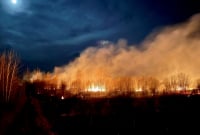Support strong Canadian climate journalism for 2025
Smoke and flames continue to engulf much of Canada, with Alberta imposing new evacuation orders, Manitoba bracing for heavy, lightning-generating thunderstorms and high wildfire risks and poor air quality from coast to coast.
Air pollution from wildfires remained well above healthy levels across much of southern and northern Ontario and several communities in British Columbia and Alberta.
Forecasters expect moderately bad air quality on Friday and Saturday throughout most of Ontario.
Meanwhile, Alberta issued two evacuation orders for Yellowhead County in the province's northwest and an evacuation alert for Grande Prairie County.
The worst air in that province is near Fort Chipewyan, which remains on an evacuation order as a fire burns out of control. Wood Buffalo and Grande Prairie also have high risk air quality forecasts.
Moderately bad air quality is forecast for Edmonton and Calgary on Friday.
In British Columbia, air quality was expected to improve almost everywhere in the province except for Fort St. John.
The number of fires burning across the country fell slightly Thursday, but forecasts suggest smoke warnings will remain in place in several provinces into the weekend.
The record setting air pollution that blanketed Ottawa and much of eastern Ontario with a yellow-tinged haze Wednesday had mostly cleared by Thursday morning. But further south, Environment Canada maintained very high-risk air quality rating in the Toronto area, southwestern Ontario and the Niagara region.
Multiple health studies have linked wildfire smoke to serious health consequences including heart attacks, strokes and breathing problems, and the poor air quality has prompted cancellations or changes to outdoor activities as a result.
The Canadian Interagency Forest Fire Centre said there were 431 fires burning on Thursday in nine provinces and two territories. That was down from 441 Wednesday, with Quebec extinguishing 10 fires since Wednesday morning.
The number of out-of-control fires also fell from 256 on Wednesday to 234 on Thursday, including a change in status for more than a dozen fires in Quebec.
The week's events prompted the second debate in the House of Commons related to climate change and fires this week on Thursday.
The Bloc and NDP accused the Liberals of claiming to be acting on climate while still subsidizing and approving the expansion of fossil-fuel projects. The Liberals blamed the Conservatives for pushing back on climate policies such as carbon pricing without offering alternatives.
More than 43,000 square kilometres have burned so far this year, making 2023 the second-worst year for fires on record. That's before the hottest months of the year have even begun.
In 2014, more than 46,000 square kilometres burned, the most ever in a single year. At the current pace, that total is expected to be passed this weekend.
Mohammad Reza Alizadeh, a climate environmental researcher at the Massachusetts Institute of Technology, is studying climate extremes including wildfires, heat waves and droughts. Alizadeh, who did his PhD at McGill University in Montreal, said in an interview this spring's unusually severe fire season in Canada is "really a clear sign of climate change."
Fires, said Alizadeh, love three things: dry fuel, windy hot weather and frequent lightning strikes. Climate change is bringing all three, he said.
This report by The Canadian Press was first published June 9, 2023.




Comments